Homeowners, home buyers, real estate developers, as well as builders, consider roofing as a very significant factor in every housing project. The quality of roofing materials cannot be compromised. Every property owner is very much concerned about the durability of building and roofing materials employed in the construction of buildings. This ensures its ability to withstand harsh weather conditions and its implications such as over-exposure to the sun, rainstorms, and winds.
The roof of a building secures and protects the whole building structure. Most often, the decision to replace or repair a damaged or worn-out roof is a tough one to make. According to Concord Roofing Company, most house owners, who find themselves in this situation, resort to a quick repair, as they feel that this decision involves less cost, time, and resources. But in reality, the devastating personal effects to your home caused by a leaking or damaged roof far outweighs the cost of replacing the roof.
Contents
What Is the Lifespan of the Different Types of Roofs?

Source: unsplash.com
Asphalt shingles
This roofing can last 15 to 30 years. Research indicates that most homeowners use asphalt shingle roofs because it is less expensive. Its composition includes cement fibers and organic materials. These elements make the asphalt shingles resistant to ultraviolet rays, the sun, wind, and heavy rains.
-
Architectural shingles
Architectural shingles are physically heavier and thicker with similar features to asphalt shingles. They are quite affordable and they provide homeowners and developers with a wide range of designs and styles to choose from. They are known to last for as long as 25 to 30 years.
-
Wood shingles
The most preferred wood shingle is made from cedar wood, whilst others also prefer pine and spruce, because it is resistant to rot and insects. They have a lifespan of up to 30 years with yearly patch-ups. It is mostly recommended for cottage-style homes. It is eco-friendly and very affordable. Wood shingles are recommended for houses in the Great Plains. Unlike the others, wood shingles are vulnerable to fire and insects.
-
Metal shingles
This roofing is very strong, alluring, and can last up to 70 years. The quality of metal and dimensions affect the cost of the roofing. It is composed of aluminum, steel, copper, and alloy, which makes it energy absorbent. Metal shingles are resilient against rain, fire, rot, and heavy winds. It is mostly recommended for houses in Northwest and Southeast America.
-
Clay tile roofs
This roofing can last 50 years or longer. They are designed in clay earthly tones. They require less maintenance, and they are very strong and dense. They do not fade, and they provide good insulation against heat and cold.
-
Composite shingles
Composite shingles consist of plastic and rubber materials. They come in various designs and color schemes and they are resistant to UV rays and heat. Composite shingles are moisture absorbent and very cost-efficient. They can last up to 60 years.
-
Slate shingles
These have very organic composites, and they are naturally very strong. They are heat and moisture resistant and have the longest life span. They can last from 50 years to a century. They are very dense compared to the others, and they can withstand all weather conditions. They are very expensive due to their highly resilient qualities. They are highly recommended for houses in mid-western America.
How To Make Your Roof Last Longer

Source: Very Cozy Home
It is absolutely necessary to consider the nature of your roof materials, the quality, and the mode of installation. Regular roof inspections are also important to ensure your roof is always in good condition. Listed here are 16 tips and practices that can extend the lifespan of your roof:
- Have a regular ventilation check on your roof.
- Clean gutters regularly so they do not get choked.
- Insulate ceilings and attics.
- Conduct regular roof inspections on Roof Cleaning Vancouver WA.
- Repair broken gutters, broken tiles, gutter leaks, and broken shingles – these issues can aggravate leakages and can eventually destroy the entire roof.
- Make sure roofing is carried out with quality materials.
- Remove patches of green moss.
- Remove dry leaves to avoid clogging of gutters.
- Get rid of hanging tree branches that may drop leaves and plant residue to stock gutters with blockage.
- Get rid of any ice residues on your roof.
- Fixed damaged roof chimneys.
- Use only qualified professionals to carry out roofing and construction services.
- Consider the climate of your specific location when purchasing and installing your roof.
- Make sure the roof is well fortified.
- Establish a sound maintenance routine.
- Finally seek expert and professional advice.
When Should You Consider Replacing Your Roof?

Source: Courier-Journal
It is of great importance to pay close attention to the condition of your roofing to make sure there are no problems that can affect the entire building. The cost of replacing your roof when it’s damaged is far less when compared to the devastating effects it can have on your house and properties. Your life may even be at stake. Here are some signals that indicate that your roof needs replacing:
- Breakages in shingles.
- Clogged gutters on the roofing
- Broken tiles
- Leakages through damaged shingles
- Damaged chimneys
- Rusty and faded roof
Dangers of Not Replacing Your Roof

Source: Exterior Solutions
Below are some examples of the destructive effects of damaged roofing:
- Roof leakages can destroy the walls and the entire building structure.
- Water stuck in a space in your room as a result of leakages can destroy property and even cause electrocution if it comes into contact with a naked wire or loose electrical connections.
- Clogged gutters on a roof can retain moisture, which can infiltrate and end up destroying the entire roof structure.
- Damaged shingles can affect your ventilation.
Do your best to seek professional expertise and assistance when replacing damaged roofing and also during roofing installation. Be sure to choose only high-quality roofing materials to prolong longevity and also to preserve the unique and beautiful style and color schemes of your roof.
Contact a local professional and experienced roofing contractor in your area. Most offer FREE quotes and inspections. They can give you their best recommendation on what is best for your situation.
